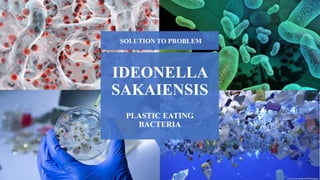
Plastic eating bacteria - Ideonella sakaiensis
- 2. • Polymer and its type • Synthetic polymer • Thermoplastic and its types • PET polymer • How PET Polymer is made • Pros and cons of PET polymer • Discovery of bacteria • Characterization of bacteria • Requirement for optimum growth for bacteria • How bacteria deals with PET polymer • Impact and applications TOPICS TO BE COVERED
- 3. IDEONELLA SAKAIESIS can decompose PET polymer BUT What is PET polymer? & How does IDEONELLA SAKAIENSIS works?
- 4. PET Kind of polymer polymer, commonly called PLASTIC IDEONELLA SAKAIENSIS, is a bacteria Can decompose PET polymer
- 5. TYPES OF POLYMER THERMOSETTING PLASTIC (cannot be melted) THERMOPLASTIC (can be melted) SEMI CRYSTALLINE (less transparent) NATURAL POLYMER AMORPHOUS (transparent) ELASTOMERS (Elastic polymer) SYNTHETIC POLYMER PET CRYSTALLINE (opaque)
- 6. SYNTHETIC POLYMER Synthetic polymers (PLASTICS) are long chain organic compounds, mostly composed of Carbon, Hydrogen, Chlorine, Sulfur, Oxygen and Nitrogen, which can be molded or shaped. Monomers of C-H compounds combined to make a long chain compounds called POLYMER. Monomer is a repeating unit cell in a polymer.
- 7. Easy to manufacture Low cost of production Thermal & chemical resistant Durable & light weight Low density & high toughness THERMOPLASTIC A VERSATILE MATERIAL
- 9. PET POLYMER • Polyethylene terephthalate is the most common thermoplastic polymer resin of the polyester family and is used in fibres for clothing, containers for liquids and foods. • PET consists of polymerized units of the monomer ethylene terephthalate, with repeating (C10H8O4) units. PET is commonly recycled and has the number "1" as its resin identification code (RIC). Melting point is • >250 ℃ • Most of the the world's PET production is involved in bottle production. • Depending on its processing and thermal history, polyethylene terephthalate may exist both as an amorphous (transparent) and as a semi-crystalline polymer.
- 10. TEREPHTHALIC ACID ETHYLENE GLYCOL POLYETHYLENE TEREPHTHALATE (PET) WATER HOW PET IS MADE POLYMERIZATION REACTION 200-250 ℃ 60 Psi
- 11. • PET production all around the world is huge. • It is manufactured for drinking water and beverages. • Plastic bottles are lighter in weight than their glass counterparts, reducing energy and costs required to ship products. • Because PET are soft and have relatively low melting points, PET bottles take less energy to manufacture than glass. SO WHAT’S THE PROBLEM THEN? PET BOTTLES
- 12. RATE OF DEGRADTION • Can remain hundreds of years without decomposing. • Most end up in landfills or as litter. • Accumulates in land and water. • It disintegrates into “MICRO-PLASTICS” . • Causing severe danger to the land and water species.
- 13. IDEONELLA SAKAIENSIS PLASTIC EATING BACTERIA Microbiology comes up with the idea of biodegradation of PET polymer in order to solve this issue to some extent. IDEONELLA SAKAIENSIS is a kind bacteria, which is famous for breaking down and consuming polyethylene terephthalate (PET) polymer resin. It is also called “PLASTIC EATING BACTERIA”.
- 14. • Ideonella Sakaiensis is a type of bacteria, lives in aerobic conditions. • Its rod shape bacteria. • It can move while having polar flagellum. • Ideonella Sakaiensis expands in form of colonies, which are colorless, smooth and circular in shape. • They are positive for catalase and cytochrome oxidase. They are also CHEMOORGANOTROPHS i.e. They can utilize organic acids, amino acids, and carbohydrates as sole carbon source. CHARACTERIZATION OF BACTERIA
- 15. Discovery of IDEONELLA SAKAIENSIS was first identified in 2016 by a team of researchers led by KOHEI ODA of KYOTO INSTITUTE OF TECHNOLOGY and KENJI MIYAMOTO OF KEIO UNIVERSITY in SAKAI, JAPAN.
- 16. Researchers did some tests in order to examine its functionality. They first isolated the bacteria from other microorganisms and then left them with sample of contaminated PET bottles in plastic bottles recycling facility. This bacteria degraded the sample and convert it back to its original constituents, also use its carbon as energy source.
- 17. POLYETHYLENE TEREPHTHALATE (PET) TEREPHTHALIC ACID ETHYLENE GLYCOL IDEONELA SAIKAIENSIS
- 18. RATE OF DEGRADATION This colony of this wild bacterium can degrade 0.2 mm thickness, low crystallinity (soft) PET polymer within six weeks. Whereas, for high crystallinity (hard) PET polymer, time becomes 30 times slower than soft polymer, approximately. REQUIREMENTS FOR OPTIMUM GROWTH • Required temperature is about 15-42 ℃, optimally 30-37 ℃. • pH for bacterial growth ranges from 5.5- 9.0, optimally 7-7.5. • Size of bacteria varies from 0.6-0.8 micrometer in width and length up to 1.2- 1.5 micrometer.
- 19. HOW IDEONELLA SAKAIENSIS ASSIMILATES PET POLYMER
- 20. APPLICATIONS This bacteria could help us to reduce the debris of PET polymer to a great extent. Faster and more broad-spectrum plastic biodegradation. Use as bio-sensors for oceanic microplastic problem. Use for biological recycling and bioremediation. It can isolate terephthalic acid, which can be reused to make new polymer without the need of petrol-based starting materials.
- 21. • https://www.nature.com/articles/s41467-019-09326-3 • https://www.popsci.com/bacteria-enzyme-plastic-waste/ • https://www.pnas.org/content/pnas/115/19/E4350.full.pdf • https://www.britannica.com/science/plastic • http://ir.nmu.org.ua/bitstream/handle/123456789/154264/108.pdf?sequence=1 REFERENCES
